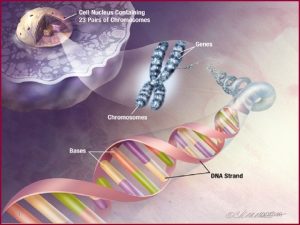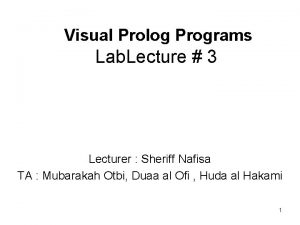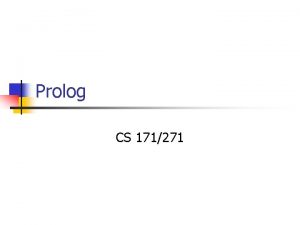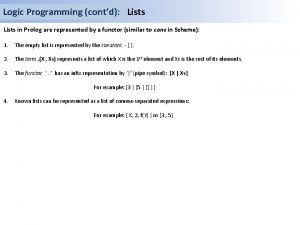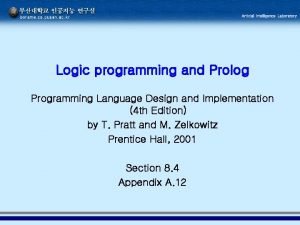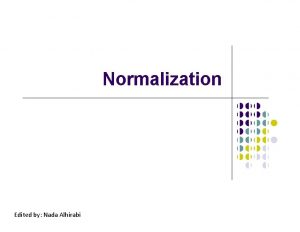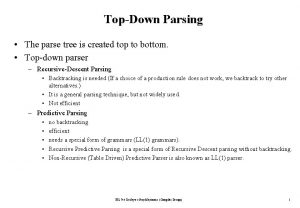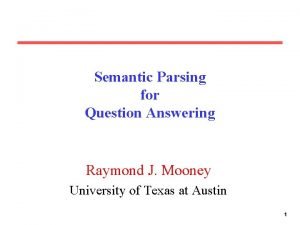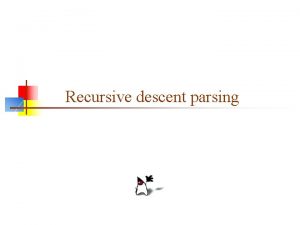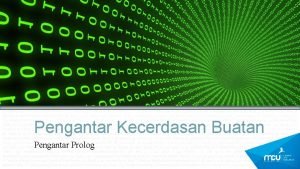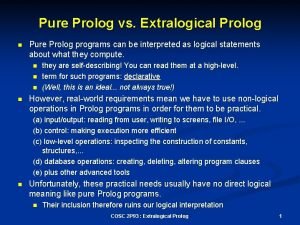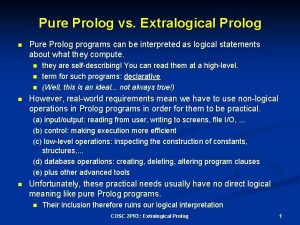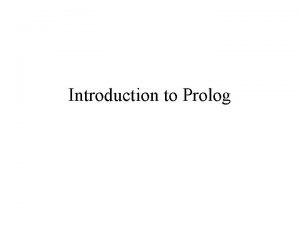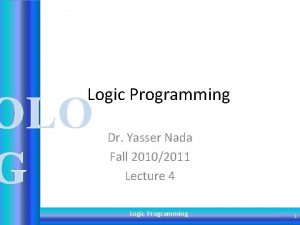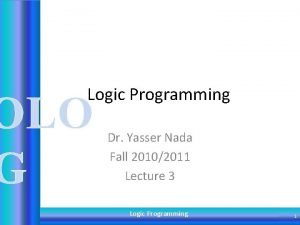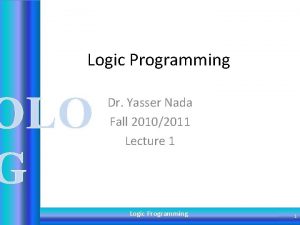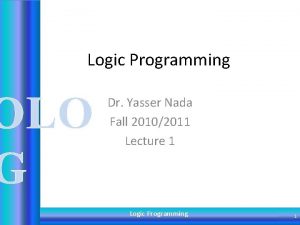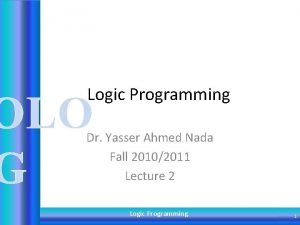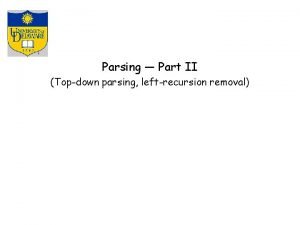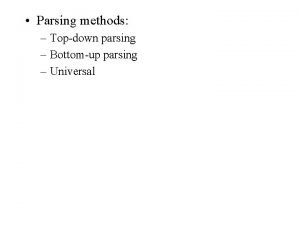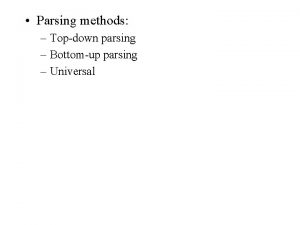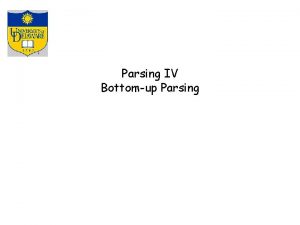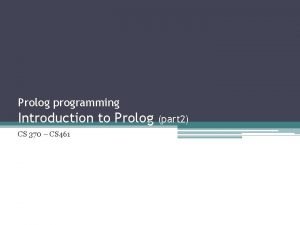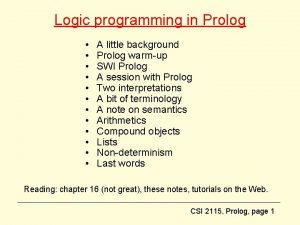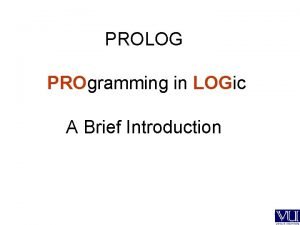prolog programming Dr Yasser Nada Chapter 8 Parsing









![Here is what happens to the query: ? - sentence([the, man, ate, the cake]). Here is what happens to the query: ? - sentence([the, man, ate, the cake]).](https://slidetodoc.com/presentation_image_h2/cba865f6334ba1adac82f755065213ba/image-10.jpg)








![what structure is returned from solving the goal: sentence(Structure, [the, man, ate, a, cake], what structure is returned from solving the goal: sentence(Structure, [the, man, ate, a, cake],](https://slidetodoc.com/presentation_image_h2/cba865f6334ba1adac82f755065213ba/image-19.jpg)




- Slides: 23

prolog programming. . Dr. Yasser Nada

Chapter 8 Parsing in Prolog Taif University Fall 2010 Dr. Yasser Ahmed nada prolog programming. . Dr. Yasser Nada

what do we want the parser to do? We would like to know that a sentence is correct according to the (recognised) laws of english grammar. prolog programming. . Dr. Yasser Nada

Simple English Syntax The components of this simple syntax will be such categories as sentences, nouns, verbs etc. prolog programming. . Dr. Yasser Nada

Here is a description Unit: sentence Constructed from: noun phrase followed by a verb phrase Unit: noun phrase Constructed from: proper noun or determiner followed by a noun Unit: verb phrase Constructed from: verb or verb followed by noun phrase Unit: determiner Examples: a, the Unit: noun Examples: man, cake Unit verb: Examples: ate prolog programming. . Dr. Yasser Nada

The Parse Tree Example : shows the parse tree for the sentence: the man ate the cake prolog programming. . Dr. Yasser Nada

sentence (s) Verbphrase (vp) Nounphrase (np) Determiner(det) The noun man verb ate Nounphrase (np) Determiner (det) noun the cake many sentences are ambiguous — because they result in different parse trees prolog programming. . Dr. Yasser Nada

First Attempt at Parsing We assume that we will parse sentences converted to list format. That is, the sentence “the man ate the cake” will be represented by the list [the, man, ate, the, cake]. We use append/3 to glue two lists together. The idea is that append/3 returns the result of gluing takes input as lists in the first and second argument positions and returns the result in the third position. prolog programming. . Dr. Yasser Nada

sentence(S): append(NP, VP, S), noun phrase(NP), verb phrase(VP). noun phrase(NP): append(Det, Noun, NP), determiner(Det), noun(Noun). verb phrase(VP): append(Verb, NP, VP), verb(Verb), noun phrase(NP). determiner([a]). determiner([the]). noun([man]). noun([cake]). verb([ate]). prolog programming. . Dr. Yasser Nada
![Here is what happens to the query sentencethe man ate the cake Here is what happens to the query: ? - sentence([the, man, ate, the cake]).](https://slidetodoc.com/presentation_image_h2/cba865f6334ba1adac82f755065213ba/image-10.jpg)
Here is what happens to the query: ? - sentence([the, man, ate, the cake]). append/3 succeeds with NP=[], VP=[the, man, ate, the, cake] noun phrase/1 fails append/3 succeeds with NP=[the], VP=[man, ate, the, cake] noun phrase/1 fails append/3 succeeds with NP=[the, man], VP=[ate, the, cake] noun phrase/1 succeeds. . . verb phrase/1 succeeds This is all very well but the process of parsing with this method is heavily non deterministic. prolog programming. . Dr. Yasser Nada

Also, it suffers from not being a very flexible way of expressing some situations. For example, the problem of adjectives: the quick fox is also a noun phrase. We might try to parse this kind of noun phrase with the extra clause: noun phrase(NP): append(Det, Bit, NP), determiner(Det), append(Adj, Noun, Bit), adjective(Adj), noun(Noun). prolog programming. . Dr. Yasser Nada

A Second Approach We now try an approach which is less non-deterministic. We will start by looking at: sentence(In, Out) The idea is that sentence/2 takes in a list of words as input, finds a legal sentence and returns a result consisting of the input list minus all the words that formed the legal sentence. We can define it: sentence(S, S 0): noun_phrase(S, S 1), verb _phrase(S 1, S 0). This declarative reading should help to bridge the gap between what we want to be a sentence and the procedure for finding a sentence. prolog programming. . Dr. Yasser Nada

Here is the rest of the parser: noun phrase(NP, NP 0): determiner(NP, NP 1), noun(NP 1, NP 0). verb phrase(VP, VP 0): verb(VP, VP 1), noun phrase(VP 1, VP 0). determiner([a|Rest], Rest). determiner([the|Rest], Rest). noun([man|Rest], Rest). noun([cake|Rest], Rest). verb([ate|Rest], Rest). prolog programming. . Dr. Yasser Nada

Prolog Grammar Rules Prolog, as a convenience, will do most of the tedious work for you. What follows, is the way you can take advantage of Prolog. This is how we can define the simple grammar which is accepted ‘as is’ by Prolog. sentence --> noun phrase, verb phrase. noun phrase --> determiner, noun. verb phrase --> verb, noun phrase. determiner --> [a]. determiner --> [the]. noun --> [man]. noun --> [cake]. verb --> [ate]. prolog programming. . Dr. Yasser Nada

It is very easy to extend if we want to include adjectives. noun phrase --> determiner, adjectives, noun. adjectives --> adjective, adjectives. adjective --> [young]. This formulation is sometimes known as a Definite Clause Grammar (DCG). prolog programming. . Dr. Yasser Nada

Essentially, the Prolog Grammar Rule formulation is syntactic sugaring. This means that Prolog enables you to write in: sentence --> noun phrase, verb phrase. and Prolog turns this into: sentence(S, S 0): noun phrase(S, S 1), verb phrase(S 1, S 0). and adjective --> [young]. into adjective(A, A 0): ’C’(A, young, A 0). where ’C’/3 is a built in Prolog Predicate which is defined as if: ’C’([H|T], H, T). prolog programming. . Dr. Yasser Nada

To Use the Grammar Rules Set a goal of the form sentence([the, man, ate, a, cake], []) and not as sentence. or sentence([the, man, ate, a, cake]) prolog programming. . Dr. Yasser Nada

How to Extract a Parse Tree We can add an extra argument which can be used to return a result. sentence([[np, NP], [vp, VP]]) --> noun phrase(NP), verb phrase(VP). noun phrase([[det, Det], [noun, Noun]]) --> determiner(Det), noun(Noun). determiner(the) --> [the]. and so on. What we have done above is declare predicates sentence/3, noun phrase/3, verb phrase/3, determiner/3 and so on. The explicit argument is the first and the two others are added when the clause is read in by Prolog. Basically, Prolog expands grammar rule with in arguments into a corresponding clause with n+2 arguments. prolog programming. . Dr. Yasser Nada
![what structure is returned from solving the goal sentenceStructure the man ate a cake what structure is returned from solving the goal: sentence(Structure, [the, man, ate, a, cake],](https://slidetodoc.com/presentation_image_h2/cba865f6334ba1adac82f755065213ba/image-19.jpg)
what structure is returned from solving the goal: sentence(Structure, [the, man, ate, a, cake], []) The result is: [[np, [[det, the], [noun, man]]], [vp, [. . . Not too easy to read! We can improve on this representation if we are allowed to use Prolog terms as arguments. For example, in foo(happy(fred), 12) the term happy(fred) is one of the arguments of foo/2. Such a term is known as a compound term. we could tidy up our representation of sentence structure to something akin to: sentence([np([det(the), noun(man)]), vp([. . . prolog programming. . Dr. Yasser Nada

Adding Arbitrary Prolog Goals Grammar rules are simply expanded to Prolog goals. We can also insert arbitrary Prolog subgoals on the right hand side of a grammar rule but we must tell Prolog that we do not want them expanded. This is done with the help of braces —{}. prolog programming. . Dr. Yasser Nada

For example, here is a grammar rule which parses a single character input as an ASCII code and succeeds if the character represents a digit. It also returns the digit found. digit(D) --> [X], { X >= 48, X =< 57, D is X-48 }. The grammar rule looks for a character at the head of a list of input characters and succeeds if the Prolog subgoals { X >= 48, X =< 57, D is X-48 }. succeed. prolog programming. . Dr. Yasser Nada

Note that we assume we are working with ASCII codes for the characters and that the ASCII code for “ 0” is 48 and for “ 9” is 57. Also note the strange way of signifying “equal to or less than” as “=<”. prolog programming. . Dr. Yasser Nada

End of chapter prolog programming. . Dr. Yasser Nada
 Tangga nada kromatis adalah tangga nada
Tangga nada kromatis adalah tangga nada Francis yasser
Francis yasser Yasser kadah
Yasser kadah Visual studio prolog
Visual studio prolog Visual prolog vs swi-prolog
Visual prolog vs swi-prolog Prolog programming
Prolog programming Prolog design
Prolog design Holocausto significado
Holocausto significado Nada te turbe taize letra
Nada te turbe taize letra Que nada te turbe que nada te espante oracion
Que nada te turbe que nada te espante oracion Nada te turbe santa teresa
Nada te turbe santa teresa Nada des enharmonis dengan nada.
Nada des enharmonis dengan nada. Estamos aqui de passagem nada trouxemos e nada levaremos
Estamos aqui de passagem nada trouxemos e nada levaremos Mateo 25 14
Mateo 25 14 Nada te turbe, nada te espante salmo 37
Nada te turbe, nada te espante salmo 37 Nada te turbe nada te espante poema
Nada te turbe nada te espante poema Perbedaan linear programming dan integer programming
Perbedaan linear programming dan integer programming Greedy vs dynamic
Greedy vs dynamic Definition of system programming
Definition of system programming Linear vs integer programming
Linear vs integer programming Definisi linear
Definisi linear Recursive descent parsing
Recursive descent parsing Semantic parsing
Semantic parsing Recursive descent parser
Recursive descent parser


